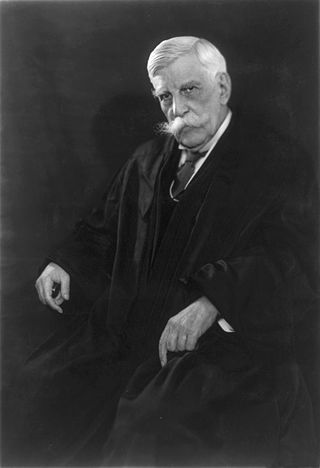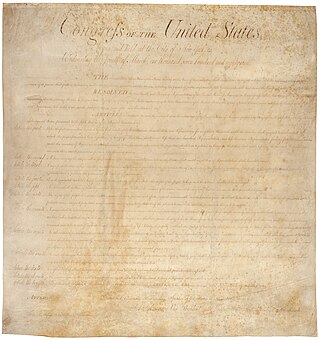Related Research Articles

The First Amendment to the United States Constitution prevents the government from making laws that: regulate an establishment of religion; prohibit the free exercise of religion; abridge the freedom of speech, the freedom of the press, the freedom of assembly, or the right to petition the government for redress of grievances. It was adopted on December 15, 1791, as one of the ten amendments that constitute the Bill of Rights.

Clear and present danger was a doctrine adopted by the Supreme Court of the United States to determine under what circumstances limits can be placed on First Amendment freedoms of speech, press, or assembly. Created by Justice Oliver Wendell Holmes Jr. to refine the bad tendency test, it was never fully adopted and both tests were ultimately replaced in 1969 with Brandenburg v. Ohio's "imminent lawless action" test.
Schenck v. United States, 249 U.S. 47 (1919), was a landmark decision of the U.S. Supreme Court concerning enforcement of the Espionage Act of 1917 during World War I. A unanimous Supreme Court, in an opinion by Justice Oliver Wendell Holmes Jr., concluded that Charles Schenck, who distributed flyers to draft-age men urging resistance to induction, could be convicted of an attempt to obstruct the draft, a criminal offense. The First Amendment did not protect Schenck from prosecution, even though, "in many places and in ordinary times, Schenck, in saying all that was said in the circular, would have been within his constitutional rights. But the character of every act depends upon the circumstances in which it is done." In this case, Holmes said, "the words used are used in such circumstances and are of such a nature as to create a clear and present danger that they will bring about the substantive evils that Congress has a right to prevent." Therefore, Schenck could be punished.
Dennis v. United States, 341 U.S. 494 (1951), was a United States Supreme Court case relating to Eugene Dennis, General Secretary of the Communist Party USA. The Court ruled that Dennis did not have the right under the First Amendment to the United States Constitution to exercise free speech, publication and assembly, if the exercise involved the creation of a plot to overthrow the government. In 1969, Dennis was de facto overruled by Brandenburg v. Ohio.
Brandenburg v. Ohio, 395 U.S. 444 (1969), is a landmark decision of the United States Supreme Court interpreting the First Amendment to the U.S. Constitution. The Court held that the government cannot punish inflammatory speech unless that speech is "directed to inciting or producing imminent lawless action and is likely to incite or produce such action". Specifically, the Court struck down Ohio's criminal syndicalism statute, because that statute broadly prohibited the mere advocacy of violence. In the process, Whitney v. California (1927) was explicitly overruled, and Schenck v. United States (1919), Abrams v. United States (1919), Gitlow v. New York (1925), and Dennis v. United States (1951) were overturned.
Whitney v. California, 274 U.S. 357 (1927), was a United States Supreme Court decision upholding the conviction of an individual who had engaged in speech that raised a threat to society. Whitney was explicitly overruled by Brandenburg v. Ohio in 1969.
Gitlow v. New York, 268 U.S. 652 (1925), was a landmark decision of the United States Supreme Court holding that the Fourteenth Amendment to the United States Constitution had extended the First Amendment's provisions protecting freedom of speech and freedom of the press to apply to the governments of U.S. states. Along with Chicago, Burlington & Quincy Railroad Co. v. City of Chicago (1897), it was one of the first major cases involving the incorporation of the Bill of Rights. It was also one of a series of Supreme Court cases that defined the scope of the First Amendment's protection of free speech and established the standard to which a state or the federal government would be held when it criminalized speech or writing.

Oliver Wendell Holmes Jr. was an American jurist who served as an associate justice of the U.S. Supreme Court from 1902 to 1932. Holmes is one of the most widely cited Supreme Court justices and among the most influential American judges in history, noted for his long service, pithy opinions—particularly those on civil liberties and American constitutional democracy—and deference to the decisions of elected legislatures. Holmes retired from the court at the age of 90, an unbeaten record for oldest justice on the Supreme Court. He previously served as a Brevet Colonel in the American Civil War, in which he was wounded three times, as an associate justice and chief justice of the Massachusetts Supreme Judicial Court, and as Weld Professor of Law at his alma mater, Harvard Law School. His positions, distinctive personality, and writing style made him a popular figure, especially with American progressives.
Abrams v. United States, 250 U.S. 616 (1919), was a decision by the Supreme Court of the United States upholding the 1918 Amendment to the Espionage Act of 1917 which made it a criminal offense to urge the curtailment of production of the materials necessary to wage the war against Germany with intent to hinder the progress of the war. The 1918 Amendment is commonly referred to as if it were a separate Act, the Sedition Act of 1918.
"Imminent lawless action" is one of several legal standards American courts use to determine whether certain speech is protected under the First Amendment of the United States Constitution. The standard was first established in 1969 in the United States Supreme Court case Brandenburg v. Ohio.
Yates v. United States, 354 U.S. 298 (1957), was a case decided by the Supreme Court of the United States that held that the First Amendment protected radical and reactionary speech, unless it posed a "clear and present danger".
Stromberg v. California, 283 U.S. 359 (1931), was a landmark decision of the Supreme Court of the United States in which the Court held, 7–2, that a California statute banning red flags was unconstitutional because it violated the First and Fourteenth Amendments to the United States Constitution. In the case, Yetta Stromberg was convicted for displaying a red flag daily in the youth camp for children at which she worked, and was charged in accordance with California law. Chief Justice Charles Hughes wrote for the seven-justice majority that the California statute was unconstitutional, and therefore Stromberg's conviction could not stand.

Masses Publishing Co. v. Patten, 244 F. 535, was a decision by the United States District Court for the Southern District of New York, that addressed advocacy of illegal activity under the First Amendment. The Second Circuit Court of Appeals overturned Hand’s ruling in Masses Publishing Co. v. Patten (1917).
Terminiello v. City of Chicago, 337 U.S. 1 (1949), was a case in which the Supreme Court of the United States held that a "breach of peace" ordinance of the City of Chicago that banned speech that "stirs the public to anger, invites dispute, brings about a condition of unrest, or creates a disturbance" was unconstitutional under the First and Fourteenth Amendments to the United States Constitution.
Kunz v. New York, 340 U.S. 290 (1951), was a United States Supreme Court case finding a requirement mandating a permit to speak on religious issues in public was unconstitutional. It was argued October 17, 1950, and decided January 15, 1951, 8–1. Chief Justice Vinson delivered the opinion for the Court. Justice Black and Justice Frankfurter concurred in the result only. Justice Jackson dissented.

In the United States, some categories of speech are not protected by the First Amendment. According to the Supreme Court of the United States, the U.S. Constitution protects free speech while allowing limitations on certain categories of speech.

The Smith Act trials of Communist Party leaders took place in New York City from 1949 to 1958. These trials were a series of prosecutions carried out by the US federal government during the postwar period and the Cold War era, which was characterized by tensions between the United States and the Soviet Union. The leaders of the Communist Party of the United States (CPUSA) faced accusations of violating the Smith Act, a statute that made it illegal to advocate for the violent overthrow of the government. In their defense, the defendants claimed that they advocated for a peaceful transition to socialism and that their membership in a political party was protected by the First Amendment's guarantees of freedom of speech and association. The issues raised in these trials were eventually addressed by the US Supreme Court in its rulings Dennis v. United States (1951) and Yates v. United States (1957).
Scales v. United States, 367 U.S. 203 (1961), was a 1960 decision of the United States Supreme Court that upheld the conviction of Junius Scales for violating of the Smith Act on the basis on his membership in the Communist Party of the United States (CPUSA).

The White Court refers to the Supreme Court of the United States from 1910 to 1921, when Edward Douglass White served as Chief Justice of the United States. White, an associate justice since 1894, succeeded Melville Fuller as Chief Justice after the latter's death, and White served as Chief Justice until his death a decade later. He was the first sitting associate justice to be elevated to chief justice in the Court's history. He was succeeded by former president William Howard Taft.
Hess v. Indiana, 414 U.S. 105 (1973), was a United States Supreme Court case involving the First Amendment that reaffirmed and clarified the imminent lawless action test first articulated in Brandenburg v. Ohio (1969). Hess is still cited by courts to protect speech threatening future lawless action.
References
- ↑ Gibson, Tobias T. (January 10, 2024). "Bad Tendency Test". Free Speech Center at Middle Tennessee State University. Archived from the original on February 2, 2024. Retrieved February 2, 2024.
- First Amendment Topics – First Amendment Center